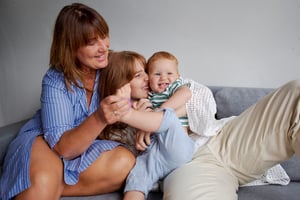As the United States enters the tenth month in quarantine due to the COVID-19 pandemic, the holiday...
Moving in With the Kids: Considering a Multigenerational Household
When I was five, my parents made a fateful decision. They invited my widowed great-aunt to live with us.
My mother's parents had both died by the time she was twelve. She was adopted by her Aunt Lillian and Uncle George, who lived in a large Newark, New Jersey, brownstone with Lillian's parents. A three-generation household came into being.
By the time my mom and dad were married, her grandparents and Uncle George had passed away. When my father was transferred to Dallas, Mom and Dad felt anxious that Aunt Lil would be alone in Newark. So began our 17-year stint as our own three-generation family.
The situation had its ups and downs. Lil had a bedroom of her own, but that was her only private space, which was probably difficult for her. Childless herself, she seemed to compete with my mom for the title of family matriarch. Reminiscing years later, my mom said that was the most challenging aspect of the arrangement.
From a child's perspective, three generations living under one roof seemed normal. It drilled into me the value of "we take care of our own." While the whole family pitched in, my mother was the primary caregiver all the way to the point where Aunt Lil was bedridden. It wasn't until Lil acquired bedsores that my parents arranged for a skilled nursing home. Ironically, the day before she was to move in, she died.
This experience drove home for me the sometimes complicated nature of a multigenerational household. While we gained much as a family, it was also stressful. Therefore, families must carefully consider the implications of older parents moving in with their adult children.
The Multigenerational Option
 Many factors must be examined before adding older adults to a household. While to some, it may be a "no-brainer," such a decision cannot be made lightly. The COVID-19 pandemic has intensified many families' urgency because older loved ones could otherwise be in a risky senior living environment. Avoiding isolation from families and friends while being in a high infection-risk environment seems like a perfect reason for older parents to join a household. Even so, rushing into such an arrangement today may create significant problems In the future.
Many factors must be examined before adding older adults to a household. While to some, it may be a "no-brainer," such a decision cannot be made lightly. The COVID-19 pandemic has intensified many families' urgency because older loved ones could otherwise be in a risky senior living environment. Avoiding isolation from families and friends while being in a high infection-risk environment seems like a perfect reason for older parents to join a household. Even so, rushing into such an arrangement today may create significant problems In the future.
Cost
Caring for older loved ones in their adult children's homes appears to cost less than most other options. However, it is best to expect some higher costs, such as groceries and utilities. If elderly parents have special needs, their adult children cannot provide, outside paid caregivers may need to visit the home. Also, there must be agreement on what, if any, household or other costs will be paid by the older loved ones.
Physical Space
It is often the case that the adult children's current home setup needs to be changed to accommodate older adults. Adaptive equipment, like grab bars or shower chairs, may need to be added.
On a larger scale, It may be necessary to build an addition or remodel the home to add space. In some communities, the "backyard bungalow" concept is growing. These smaller square footage outbuildings allow older adults to live in a separate structure while being close to family caregivers.
Homebuilders are also offering "multigenerational homes." These are built with independent private living spaces along with common areas. The private areas may include separate kitchens and entrances. In some families, selling both the parent's and adult children's current homes serves as a means to finance the single multigenerational home.
Caregiving
 A big driver in forming a multigenerational household with older adults is the perception that family can deliver better caregiving. The advantages are that families know their elders better than the staff at a senior living facility ever could. This arrangement also eliminates the anxiety families sometimes feel worried about a frail loved one's welfare.
A big driver in forming a multigenerational household with older adults is the perception that family can deliver better caregiving. The advantages are that families know their elders better than the staff at a senior living facility ever could. This arrangement also eliminates the anxiety families sometimes feel worried about a frail loved one's welfare.
There can be many downsides, as well.
Families often lack the in-depth knowledge and skills needed to care for older adults. My mom lacked the knowledge about turning a bedridden person over several times per day to avoid bedsores. This would have been second nature for a trained, skilled nursing staff but instead resulted in a painful and expensive hospital stay for Aunt Lil.
Dementia care falls into its own challenging category. It's not uncommon for people living with dementia to wander away from home, thereby endangering their lives. Dedicated memory care facilities have trained staff and an environment designed to keep residents safe and calm. A multigenerational home frequently is less secure despite the best efforts of the family.
Then there is the stress on the family caregivers. For an older adult with fewer health issues, the caregiver's responsibilities might be minimal. However, for those requiring more attention, the pressure on caregivers can become overwhelming. Unlike senior care facility professionals, family members don't punch out and relax after an 8-hour shift. The family is on duty 24/7.
Analyzing All the Options
 Families and their older loved ones need to answer difficult questions before committing to the multigenerational alternative.
Families and their older loved ones need to answer difficult questions before committing to the multigenerational alternative.
- Is the existing living space adequate? If not, are there affordable alternatives for adding space?
- Depending on the older adult's health needs, is the family prepared to provide adequate care? It's essential to remember that a healthy senior today could quickly decline and require much more care.
- Does the financial picture make sense? For example, quitting a job to provide care at home may put the family in a financial hole for years. The economic contribution of all parties needs to be discussed. This may include adult siblings who live elsewhere.
- What happens to social events and vacations if the family is continuously tied up at home? These may be necessary opportunities to get a break if the caregivers can get away.
- Which family members will be available for caregiving duties? Can adult siblings or older children help?
- Will too much togetherness eventually cause tension in the home? Lack of privacy and independence could create conflict.
- Are all parties able to have an ongoing, honest dialogue about the arrangement? Uncovering and discussing all reservations about the situation before everyone commits will reduce the risk of future problems.
If discussing these and other relevant questions indicate that the multigenerational household doesn't make sense, other options must be considered.
For example, is it possible for an older adult to continue living at home with such support as visiting nurses and Meals on Wheels? While this idea may have initially discarded, it may need to be reexamined. There are more services than ever being provided to help seniors stay in their homes as long as it is safe and healthy.
The assisted living, memory care, or skilled nursing care options also may be put back on the table. Depending on the specific needs of a loved one, these alternatives, which seemed too expensive at first, may now feel more reasonable.
Making the Move
After careful analysis, forming a multigenerational household may be the best option for some families. These living situations represent a growing trend. A Pew Research Center study found that in 1995, "7% of adults living in someone else's household are a parent of the household head." By 2017 the percentage increased to 14%.
As in my own experience, there are ups and downs to a multigenerational household. Personally, I gained a lot despite the stresses. For other families, it could be a profoundly poor choice. The only way to decide correctly is to courageously answer all the questions.
Learn more about relocation options on our Housing Resources page.







